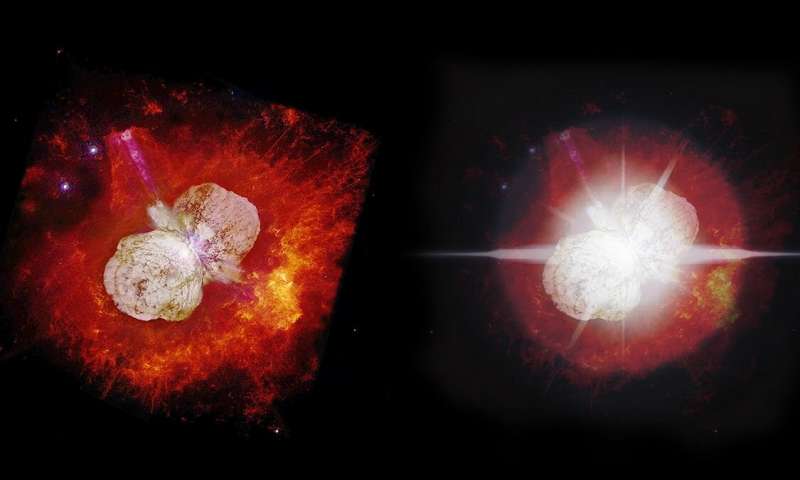For over a century and a half, Eta Carinae has been one of the most luminous – and most enigmatic – stars of the southern Milky Way.
Part of its nature was revealed in 1847, when, in a giant eruption, it ejected a nebula called the Homunculus (“little man”). The event made Eta Carinae the second-brightest star in the sky after Sirius, visible even in broad daylight and (later) easily distinguishable from other, similarly unstable stars called Luminous Blue Variables, whose nebulae are not so clearly visible.
Aside from making Eta Carinae one of the most beautiful and frequently photographed objects in the night sky, the giant Homunculus contains information about its parent star, ranging from the energy of its expansion to its bipolar outflow and chemical composition.
In as little as a decade from now, however, we will no longer be able to see the nebula clearly.
A recent study indicates that the Homunculus will be obfuscated by the increasing brightness of Eta Carinae itself. So rapidly is it growing, in fact, that in 2036 the star will be 10 times brighter than its nebula, which in the end will make it indistinguishable from other LBVs.
Find your dream job in the space industry. Check our Space Job Board »
Good news
But there’s an upside.
A team of 17 researchers led by Brazilian astronomer Augusto Damineli, with input from Université de Montréal’s Anthony Moffatt, believe that the increasing brightness of Eta Carinae is not intrinsic to the star itself, as is commonly believed. In fact, it is likely caused by the dissipation of a dust cloud positioned exactly in front of it as seen from the Earth.
This cloud, the researchers posit in a new study in the Monthly Notices of the Royal Astronomical Society, completely shrouds the star and its winds, blotting out much of its light emanating towards Earth. The surrounding Homunculus, by contrast, can be seen directly because it is 200 times larger than the obscuring cloudlet and its brightness is thus almost unaffected.
In 2032 (with an uncertainty of plus or minus four years), the dusty cloud will have dissipated, so that the brightness of the central star will no longer increase and the Homunculus will be lost in its glare, the research team believes.
And that will provide an opportunity for deeper study of Eta Carinae itself, even showing that it is not one, but in fact two, stars.
“There have been a number of recent revelations about this unique object in the sky, but this is among the most important,” said Moffat. “It may finally allow us to probe the true nature of the central engine and show that it is a close binary system of two very massive interacting stars.”
Provided by:
University of Montreal
More information:
A Damineli et al. Distinguishing Circumstellar from Stellar Photometric Variability in Eta Carinae. Monthly Notices of the Royal Astronomical Society (2019). DOI: 10.1093/mnras/stz067
Image:
(L) A view of Eta Carinae by NASA’s Hubble Space Telescope in 2000. (R) What the star could look like in 2032, when it overshadows its nebula.
Credit: University of Montreal











